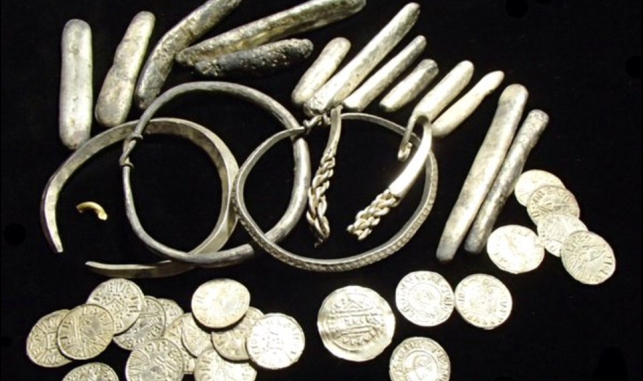
A hoard of Viking silver, jewelry and Saxon coins was discovered by a metal detectorist in a field in Oxfordshire.
The ‘significant’ treasure trove of 186 coins, ingots and jewellery was uncovered by amateur treasure-hunter James Mather, in a farmer’s field near Watlington in October.

BYPASS THE CENSORS
Sign up to get unfiltered news delivered straight to your inbox.
You can unsubscribe any time. By subscribing you agree to our Terms of Use
Latest Video
The find should shed some light on the period of Anglo Saxon history that saw King Alfred the Great of Wessex defeat the Viking Danes, and then go on to banish his one-time ally, King Ceolwulf II of Mercia, from history.
The Daily Mail reports:
More than 200 pieces of silver including Viking coins, ingots and jewellery dating back to the 870s AD have been unveiled at the British Museum in London.
The treasure is thought to have been buried at the end of the century, in the period following Alfred the Great of Wessex’s defeat of the Vikings at Edington in Wiltshire.
The ‘nationally significant’ artefacts were unearthed by a metal detectorist near Watlington, Oxfordshire, in October last year and reveal clues as to how Alfred the Great of Wessex and King Ceolwulf II of Mercia may have co-operated to battle the invaders.
James Mather, 60, had been hunting for treasure for five hours and was about to go home when he chanced upon the cache of valuable Viking items.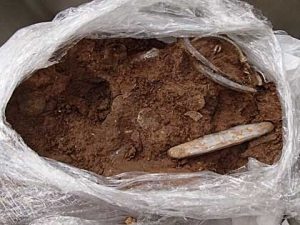
Some of the coins were minted during the reign of Alfred the Great, ruler of the Anglo-Saxon kingdom of Wessex from 871 and 899 AD and others are said to have been minted for King Ceolwulf II of Mercia, who ruled between 874 and 879 AD.
At this time, England was split into kingdoms. Alfred the Great ruled Wessex which covered the west and majority of south England, excluding Cornwall, while Mercia was ruled by King Ceolwulf II and covered the River Trent and the Midlands.
Three types of penny were found that were issued in Ceolwulf’s name and were designed in the ‘Cross and Lozenge’ style, also used by King Alfred.
Due to the fact the reigns of these rulers overlapped, and that King Ceolwulf’s coinage is similar in style and design to that of Alfred of Wessex, it has been suggested the two teamed up to fight against the Vikings.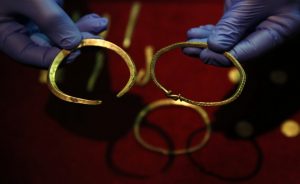
Elsewhere, seven pieces of Viking jewellery including and 15 ingots were also found.
This find includes 186 rare coins of King Alfred of Wessex & King Ceolwulf II of Mercia, as well as Viking jewellery pic.twitter.com/xs57cK4WCL
— British Museum (@britishmuseum) December 10, 2015
Academics from the British Museum and the Ashmolean in Oxford believe the hoard was buried around the end of the 870s, in the period following Alfred’s decisive defeat of the Vikings at Edington in 878.
At the Battle of Edington, King Alfred’s army is reported as defeating what was called the ‘Great Heathen Army’, led by Guthrum in May 878 AD.
Four years previously, historical reports claim Mercia and its army had collapsed. Guthrum made several attacks on Wessex from 875, and by early 878, his army occupied parts of the east and north east of England.
In Spring 878 AD, King Alfred marched to Edginton with West Saxon soldiers to take on Guthrum.
The West Saxon troops won the battle and King Alfred cut off supplies to Guthrum’s army who had taken refuge in Chippenham.
A recent major discovery was this Viking hoard buried in the 870s in Watlington, Oxfordshire pic.twitter.com/SJy3HbNzn9 — British Museum (@britishmuseum) December 10, 2015
The Vikings asked King Alfred for a truce, which was granted as long as they left his kingdom immediately, and later became known as the Peace of Wedmore.
In particular, the experts believe the Viking treasure was buried when the Vikings moved north of the Thames and Guthrum returned to East Anglia where he was converted to Christianity with Alfred as his sponsor.
Nearly all of the objects come from the time of the ‘Last Kingdom’ when the Anglo-Saxon kingdoms of Mercia and Wessex were fighting for their survival from the threat of the Great Heathen Army.
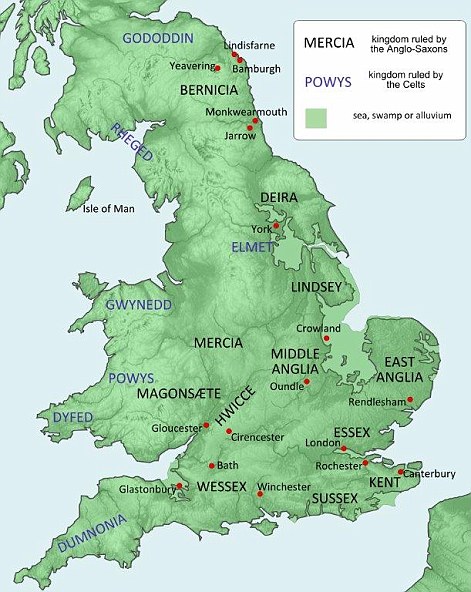 The fight ultimately led to the unification of England and its kingdoms.
The fight ultimately led to the unification of England and its kingdoms.
Viking silver casts light on the era of King Alfred the Great, according to the Guardian:
Alfred the cake burner and Viking beater is one of the most famous kings in British history, but poor Ceolwulf is only known from a list that says he reigned for five years. His fate is unknown, and the only accounts of his character come from Alfred’s side – after the victorious Alfred also annexed Mercia – describing him as foolish and a puppet of the Vikings.
The newly found coins cover several years and were struck in different mints, demolishing the earlier belief that the two kings issued coins in only one year, marking a very short-lived alliance.
Gareth Williams, curator of early medieval coinage at the British Museum said: “This is not just another big shiny hoard.” He said it was evidence about a poorly understood time in the development of England. Even the scrap of gold, chopped up to use as currency by weight, shows the emergence of a gold standard.
The coins, he said, offered insight into a coalition that broke up acrimoniously after a few years, leading to one partner disappearing without trace. “They give a more complex political picture of a period which has been deliberately misrepresented by the victor.” He added, diplomatically, that the relationship of Stalin and Trotsky came to mind.
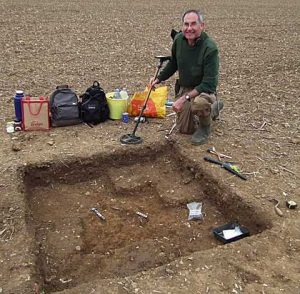 Mather, a hobby metal detectorist for more than 20 years, had had a long dull day of uncovering metal ring pulls and cartridge cases and was ready to head home when he found what he thought might be a Viking silver ingot, similar to one he had seen in the British Museum. He dug a nine-inch hole revealing a great mass of coins, he recalled.
Mather, a hobby metal detectorist for more than 20 years, had had a long dull day of uncovering metal ring pulls and cartridge cases and was ready to head home when he found what he thought might be a Viking silver ingot, similar to one he had seen in the British Museum. He dug a nine-inch hole revealing a great mass of coins, he recalled.
He phoned the local officer who records finds under the portable antiquities scheme, which tracks the discovery of small archaeological objects, many less commercially but equally historically valuable. Then, heroically obeying orders, he filled in the hole again. He admitted he made many anxious return visits over the weekend to check the field was still undisturbed.
The following Tuesday the finds officer, David Williams, sent the farmer to buy some clingfilm – “the best quality clingfilm,” he specified – and carefully excavated down to expose the hoard, and lifted the whole block of clay holding the silver. It was supported on an oven tray, also borrowed from the farmer, and brought to London in a suitcase. “That’s when I discovered that they don’t like it at the British Museum when you wheel a piece of luggage through the galleries – even if you assure them it contains a Viking hoard,” Williams said.



